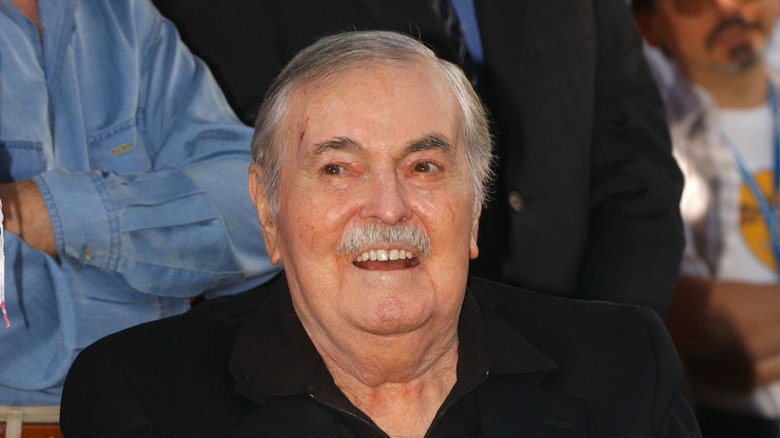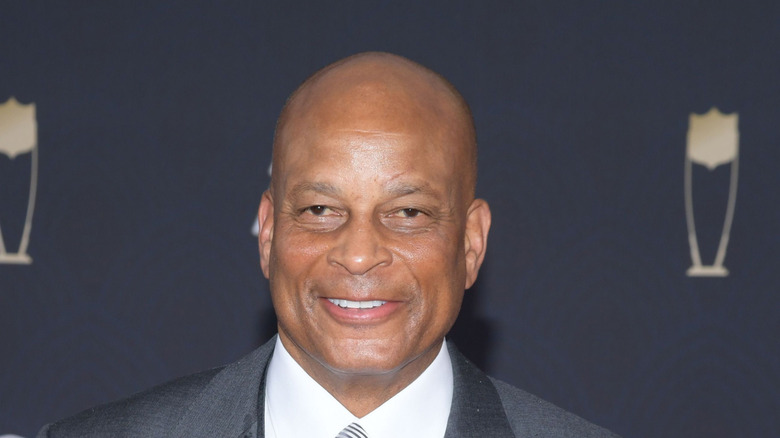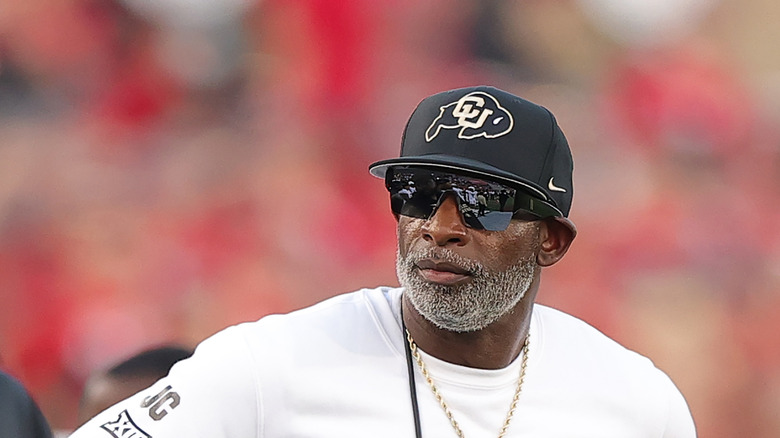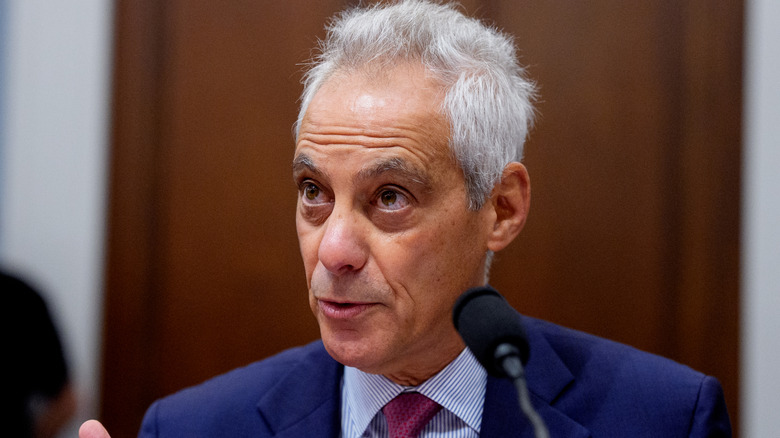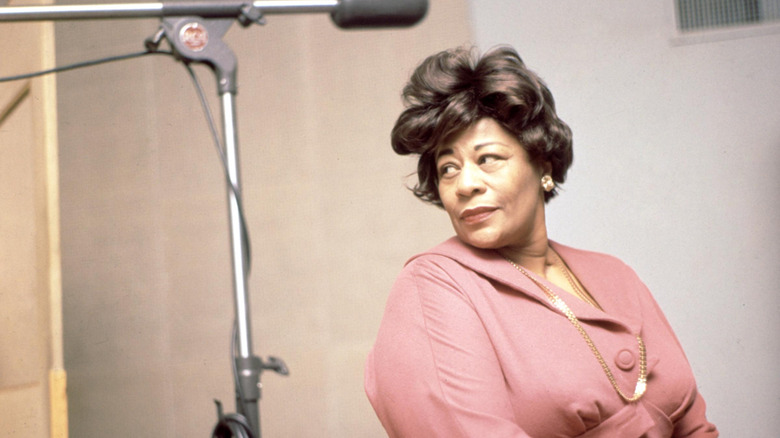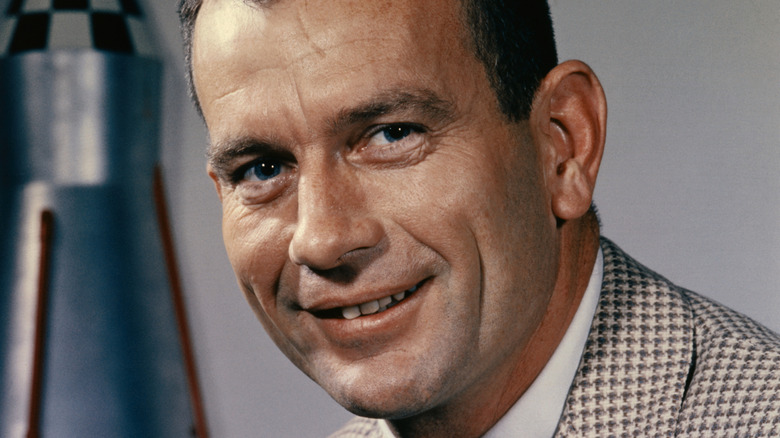Celebrities You May Not Know Are Missing Body Parts
Sometimes it seems like celebrities aren't really people. Yet we still feel connected to them because they're constantly appearing on movie or TV screens, giving speeches, or performing some amazing act in a sports venue, and that footage lives forever. But celebrities are, of course, real people, and they're not spared from the potential disadvantages or significant setbacks that life can cruelly and callously dish out.
A number of celebrities experienced great physical harm, either before they were even born or as the result of a traumatic accident or difficult illness. There's even a small group of famous people who are missing a body part, be it a finger, extremity, or an entire limb. They also kept their loss largely out of public view, either because it wasn't a big deal to them or they didn't think it ought to be. Here are some major public figures who lost a part of themselves along the way.
James Doohan
Taking part in D-Day was a frightening, deadly, and important moment for the Allied soldiers who landed on the beaches of Normandy in the pivotal World War II battle in June 1944. Of the 160,000 American, Canadian, and British troops who took part, more than 10,000 were reported killed, missing, or seriously hurt, among them James Doohan. The actor later became a sci-fi legend for his role as Captain Montgomery "Scotty" Scott, chief engineer of the USS Enterprise on the original 1960s "Star Trek" series and in various TV and video game spinoffs and seven big-screen features.
Joining the Royal Canadian Artillery in 1939, the Ontario native was quickly made lieutenant and trained for D-Day operations in the U.K. Doohan saw major action on D-Day, eliminating two snipers and leading a squadron through an area riddled with landmines. On the night after the initial invasion, Doohan was shot by another Allied troop during a mix-up over passwords at a command post. That individual fired six times at Doohan — four bullets hit his leg, and one struck a finger. Taken out of active duty, Doohan was sent to a hospital in England, where surgeons at first removed the top third of his digit. The future actor had trouble moving what remained, so he decided to have the entire finger amputated.
Erik Stolhanske
Eric Stolhanske met a group of comic actors at the improv troupe he formed at Colgate University, and they became the Broken Lizard collective. Since the early 2000s, it has made a number of cult-beloved comedy movies, including "Super Troopers," "Club Dread," and "Beerfest." Stolhanske only got into acting when he had to walk away from his goal of playing high-level baseball, which was tough to do with a prosthetic leg. The actor was born without a fibula, one of the two bones that make up the lower leg. "It was just one of those genetic mistakes," he told Pro Rhetoric.
As a child, he wore a wooden substitute for the appendage, and he's since graduated to more complex models made of more advanced materials. Having to wear a prosthesis also prepared Stolhanske for improv and comedy, because he was so self-conscious about the leg in college that he'd make up lies about his situation while flirting with women. He would say it was the result of a motorcycle crash, an injury sustained while running with the bulls in Spain, or that he was attacked by fishermen while swimming with whales.
Ronnie Lott
Ronnie Lott was one of the greatest defensive backs to ever play in the NFL. He helped the San Francisco 49ers to four Super Bowl titles in the 1980s, and across his 14-year career, he earned 10 Pro Bowl invitations. In 2000, he was inducted into the Pro Football Hall of Fame.
A secret the NFL doesn't want the public to know is that players will go to extreme measures to keep playing. It's possible or probable that Lott's storied career may not have reached the heights it did in the late 1980s if he'd made a different decision regarding an injury sustained in 1985. After he broke a pinkie finger in a game, Lott elected against having pin-installation surgery to reset the digit and take time off for recuperation. Instead, he had surgeons amputate the finger. "I was trying to laugh it off, but I felt sick," Lott told the Associated Press of the first time he saw his four-fingered hand in 1986 (via Sports Illustrated). "It was just a total shock. I thought, 'Oh, man, I should have had the pin put in."
Deion Sanders
One of the few and best multiple-sport athletes, Deion Sanders played Major League Baseball and NFL football during the same era. The solid-hitting centerfielder knocked a home run for the New York Yankees in 1989 just a few days before he scored a touchdown for the Atlanta Falcons in his first NFL game. The defensive back and wide receiver went on to win two Super Bowls, join the Pro Football Hall of Fame, and, since 2022, coach the University of Colorado's football team.
In September 2021, Sanders had what he thought was minor surgery to correct a nerve inflammation and toe dislocation. Weeks later, his two leading toes on his left foot began to turn black, sending him back to the hospital. The cause of the complication: Three blood clots in the leg's femoral artery. Sanders was also diagnosed with compartment syndrome, which limited circulation to the foot, causing calf swelling and excruciating pain. After considering amputation of Sanders' lower leg, doctors performed a pressure-relieving surgery and then amputated two toes in order to save his life.
Rahm Emanuel
One of the most public-facing members in President Barack Obama's administration, former U.S. congressman Rahm Emanuel acted as White House chief of staff for two years. In 2010, he left the position to run in the mayoral election for his hometown of Chicago. Emanuel won in a landslide and held the position as the top elected official in one of the U.S.'s largest cities until 2019.
Before his career in public service, Emanuel worked in fast food, employed at a Chicago-area Arby's. Tasked with cleaning a machine used to thin-slice roast beef, he accidentally cut off one of his middle fingers. Emanuel dressed the wound himself before he could receive medical attention, but he still wound up with a variety of medical problems resulting from the inadvertent amputation. "I ended up with five blood infections, two bone infections, gangrene, seven weeks in the hospital, a 105 fever, and was about one day away from looking at the other side of the ledger," he told Katie Couric on "60 Minutes."
Jim Abbott
A heavily hyped pitching phenom, Jim Abbott was named America's top amateur athlete in 1987. He also won a gold medal with the U.S. Olympic baseball team in 1988, and after he was drafted, he skipped the minor leagues entirely to go straight to the mound for the California Angels in 1989. The Rookie of the Year candidate played in the majors for 10 seasons, where he won nearly 100 games, struck out almost 900 batters, and pitched a no-hitter in 1993.
Abbott was an elite pitcher on every level, and he accomplished everything without a right hand. Born without the appendage, he developed and perfected a pitching style that involved hurling the ball with his left hand and then quickly moving his fielding glove from his right arm back to his hand to field. One of the first and few professional athletes to play despite the absence of an extremity, Abbott was a cited inspiration to NFL linebacker Shaquem Griffin and U.S. women's national soccer team player Carson Pickett, both of whom were born without a hand.
Ella Fitzgerald
Ella Fitzgerald is celebrated as arguably the greatest jazz singer of the 20th century, if not of all time. She was "the first lady of song" who could handle any material she attempted, performing jazz, blues, pop, and opera with aplomb. Over her career, Fitzgerald recorded with and was praised by the likes of Bing Crosby, Duke Ellington, Count Basie, and Cole Porter.
Fitzgerald's career lasted 60 years, and she performed well into the 1990s, slowing down when health prevented her from working as much. In 1994, Fitzgerald's spokesperson, Mary Jane Outwater, revealed that in the previous year, the singer had undergone two separation amputation surgeries, one for each leg. She endured complications of diabetes and had experienced vision loss and circulatory issues, which led to the medically necessary procedures in which doctors removed the legs at the knee. She never made another public appearance, and the tragic real-life story of Ella Fitzgerald came to an end in 1996.
Cole Porter
Many of the jauntiest, catchiest, and most definitive songs of the early 20th century, the tunes that comprise the Great American Songbook, sprang forth from the mind of composer and lyricist Cole Porter. He was as famous and well-liked as the singers who performed his many sunny classics, including "Anything Goes," "I Get a Kick Out of You," and "Night and Day." But behind the music, Porter's life was characterized by tremendous physical pain.
Porter was an avid horseback rider, and in 1937, his animal became startled and ran over his legs. He suffered compound fractures in both thighbones, which invited the development of osteomyelitis, an often drug-resistant infection that settles in bone. Porter submitted to numerous corrective operations over the following two decades, including a particularly harsh 1945 surgery. His legs were purposely broken, and eight inches of leg bones in total were removed, with the remaining parts fused together. In 1958, infections took over the bone marrow to such a point that the musician's right leg, from the thigh down, was removed.
Deke Slayton
After flying 63 combat missions during World War II, Donald "Deke Slayton" served as an Air Force flight instructor, an aeronautical engineer, and then a test pilot. That gave Slayton the experience necessary to head to space. Selected as one of the original Mercury 7 astronauts in 1959, he was pulled from the project because of a heart problem. Slayton moved into a career as an administrator for NASA, and after medical clearance, he went into space in 1975 for an extraterrestrial orbital meeting of American astronauts and Soviet cosmonauts.
A heart issue slowed Slayton's astronaut ambitions, but another medical issue didn't give NASA much pause: a missing finger. Slayton grew up on a family farm in Wisconsin, and at the age of 5, he attempted to declog his father's horse-drawn mower and severed his left hand's ring finger. "I reached down there to clean the bar off, and about that time the horses took this one step ... it went click and zipped that finger right off," he wrote in "Deke!" Slayton said the injury "didn't hurt," but his dad was understandably upset. "He took me uptown, where they trimmed it off," he explained.
Jerry Garcia
As the leader and major musical director of the Grateful Dead, one of the most important rock bands of the 1960s, Jerry Garcia was one of the most influential rockers ever. The singer and guitarist guided his band for more than 30 years and inspired the jam band genre and the Deadheads subculture. Even die-hard fans of the Grateful Dead may not know that Garcia, regarded as one of the best rock guitarists of all time, played his very tricky instrument with only nine fingers.
Garcia lost one of his digits long before his musical career began in earnest due to a childhood incident — a game of "chicken" that went too far. Tiff Garcia and his younger brother, Jerry, were playing around with wood and an axe. "He was putting little pieces of twigs on the sawhorse, or whatever, and I was chopping them in half, making kindling," Tiff recalled in "Move Me Brightly," a filmed tribute to his brother, who died in 1995. "And he did this: He'd put his finger there and take it away. That happened a dozen times. Finally, I just nailed him." Jerry Garcia sustained an axe cut so deep and profound that the finger was unsalvageable, and doctors had to surgically amputate what remained.
Zsa Zsa Gabor
By the 1980s, Zsa Zsa Gabor was famous for being famous, and her every exploit was reported by tabloid magazines and gossip columnists. Born in Hungary, she appeared in a string of B-movies and early TV shows as glamorous and beautiful characters before eventually making a career out of playing herself in cameos, playing off her image as a self-aggrandizing celebrity and socialite who got married nine times.
Gabor's last husband, from 1986 until her death in 2016 at age 99, was a legacy German prince named Frederic Prinz von Anhalt. He acted as Gabor's advocate and spokesperson when her health took a downward turn in the 2010s. In 2011, Gabor's right leg, from above the knee, was surgically removed by doctors. The celebrity was in such a poor state of health that she wasn't aware of the procedure and was unable to feel it because she couldn't use her hands. "It took over a half a year" for Gabor to learn of her own amputation, von Anhalt told Page Six.
Dean Winters
Tough-guy character actor Dean Winters is probably best known for his roles on "Oz" and "Law and Order: SVU" or for playing sleazy beeper salesman Dennis Duffy on "30 Rock." But really, his ongoing work as the personification of the concept of Mayhem in chaotic, slapstick commercials for Allstate. That career-defining part was the first acting work Winters landed after a lengthy medical ordeal that nearly killed him. He awoke one day in 2009 with a fever, and the next day, his skin went black in his doctor's office, his head swelled, and he lost consciousness. On the ambulance ride to a hospital, Winters' heart stopped beating for over two minutes, meaning he was technically dead. Successfully revived, he spent three weeks in intensive care being treated for a bacterial infection.
After he was sent home, gangrene developed and spread, and Winters spent 95 more days under medical care, where he endured 17 surgeries. Doctors weren't able to save some of his body parts from the infection, and they surgically amputated part of one of Winters' thumbs and two of his toes. "I haven't taken a step since 2009 without being in pain," he told Page Six. "I've got neuropathy on, you know, on a whole different level where I can't feel my hands and my feet."
Bob Kerrey
One of the most prominent and high-profile Democratic politicians in the 1980s and 1990s, Bob Kerrey was elected governor of Nebraska in 1982 and then moved on to the U.S. Senate in 1988. After being named to intelligence, finance, and agriculture committees, he headed the Democratic Senatorial Campaign Committee and ran for the Democratic nomination for president in 1992. Prior to his work in government, Kerrey was a highly decorated officer in the U.S. Navy after being drafted to fight in the Vietnam War. Dispatched as a member of a 14-person Navy SEAL squad, Kerrey would eventually be awarded the Congressional Medal of Honor, the Bronze Star, and a Purple Heart for his campaign heroics.
Kerrey's Vietnam service lasted for three months, ending after a skirmish with soldiers from the Viet Cong. Seven opponents died in the violence, and a grenade struck Kerry, the leader of the battalion. He was hurt in the chest, face, and groin, but his foot sustained most of the damage. Sent back to the Philadelphia Naval Hospital, his leg had been so destroyed that surgeons amputated the bottom half of Kerrey's right leg.

